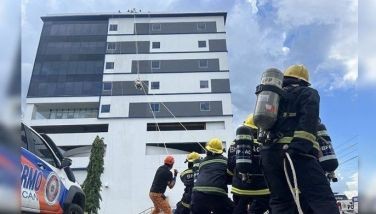Build back better

After being rocked by powerful earthquakes in 2010 and 2011, the New Zealand city of Christchurch is on full recovery mode.
Last year when I went there, the cardboard cathedral had not yet been put up as temporary replacement for the iconic Anglican Christchurch Cathedral that was flattened in the quakes. But a trendy commercial center was in place at Ground Zero – the city’s Central Business District. The shops and cafés in that area were built out of jazzed up shipping containers.
Around the city there were still many structures lying in ruins, and people talked of friends who had left the city for good. But the energy in the rebuilding was palpable.
Today the Transitional Cardboard Cathedral of Christchurch is a tourist draw and a model of “emergency architecture.†It was designed by Japanese architect Shigeru Ban. Of the 185 fatalities in the quake, 28 were Japanese – the biggest foreign group among the victims.
The Cardboard Cathedral could prove to be even more popular than the permanent structure that will replace the ruined church.
Those involved in Christchurch’s reconstruction refused to give in to despair. Preferring to look on the bright side, they told me they saw the colossal work ahead as an opportunity to create jobs, lure investment and stimulate economic growth.
And while a part of their heritage had been lost in the destruction of their landmarks, the optimists also saw the devastation as a chance to build a better city.
* * *
“Build back better†is a buzz phrase among the multinational teams involved in relief work, now transitioning to rebuilding, in the areas ravaged by Super Typhoon Yolanda.
The current focus is on emergency architecture, with the Israelis, for example, providing the technology and materials to rapidly set up schoolhouses and restart classes. The Germans are assisting in water purification and provision of emergency power service.
Next week two experts from Chile are arriving to share their experiences in reconstruction after a magnitude 8.9 earthquake flattened many areas of southern Chile.
A Philippine military official directly involved in the relief effort told me last week that they needed “sandwich panels†for emergency architecture. He said the prefabricated panels, consisting of an insulation core sandwiched between two color-coated steel sheets, are cost-effective and can be installed within six hours.
The World Bank’s Japanese country director, Motoo Konishi, said their group is assisting the Philippines in designing houses and buildings that are more resilient to powerful earthquakes, super typhoons and torrential flooding.
“It’s an opportunity to build back better,†said Al Dwyer, East Asia-Pacific regional advisor of the Office of US Foreign Disaster Assistance (OFDA) of the US Agency for International Development. USAID is helping in the provision of temporary shelters and seeds in the disaster zone.
The challenge, OFDA director Jeremy Konyndyk told me, is giving victims the confidence to restart their lives.
Dwyer has been to Tacloban and is happy to note that the typhoon survivors are eager to rebuild their city.
“People down there are very energetic,†Dwyer told me. “There’s a lot of self-help. They’re rebuilding on their own.â€
* * *
Obviously, rebuilding is an enormous task. Even New Zealand, one of the wealthiest and most competitive nations, did not get off to a running start in its post-earthquake reconstruction. When I was there, people were griping about the slow processing of insurance claims, which delayed even rubble clearing. There was a spirited debate on whether to restore ruined landmarks or raze them and build entirely new structures.
A similar debate raged over rebuilding or abandoning ruined structures after New Orleans was devastated by Hurricane Katrina’s storm surge, Konyndyk said.
Those are wealthy countries. In dirt-poor Haiti, over 170,000 people continue to live in tent communities after the killer earthquake in January 2010.
We don’t have the resources of the US or New Zealand, but we also don’t have Haiti’s kind of poverty and weak government, which has failed to utilize the massive amount of foreign aid to build better after the earthquake.
Much depends on people themselves. Thailand’s Phuket, which was destroyed by the 2004 Indian Ocean tsunami, got to work ASAP on reviving tourism, its main industry. Tourists of Chinese descent in particular shied away after the tsunami, considering death by water one of the worst ways to end a life.
The Thais, however, did not lose hope. They quickly launched an international marketing campaign to bring back the tourists. I remember colleagues returning from Phuket at the time with stories of ghosts haunting the hastily constructed beachfront cottages and even taxicabs. Those colleagues were no believers in the afterlife and simply related strange experiences that they could attribute only to the supernatural. But the Thais’ effort worked and Phuket quickly bounced back.
Today the Thais say they have learned their lesson and are better prepared for tsunamis and other disasters.
Bohol, recently destroyed by a magnitude 7.2 earthquake, can speed up its recovery through its tourism industry, which is dependent mostly on natural attractions. Fishing communities destroyed by Yolanda can also recover – as soon as they can get boats and nets for their livelihood.
Recovery is tougher for those dependent on the copra industry. All those toppled coconut trees may be good for coco lumber, but the debris must first be cleared before replanting can be done. And reviving coconut plantations can take two to three years.
Tacloban can take a cue from Christchurch and consider the rebuilding as an opportunity for job creation and investment.
To stimulate commercial activity, the city will have to cut the red tape that bedevils everyone doing business with local governments in this country. This can be an opportunity for Tacloban to set an example in becoming a competitive investment destination.
If the residents’ zeal to recover is sustained, building a better Tacloban is possible.
“That city will come back,†Dwyer said. “I’m sure of it.â€
- Latest
- Trending


























